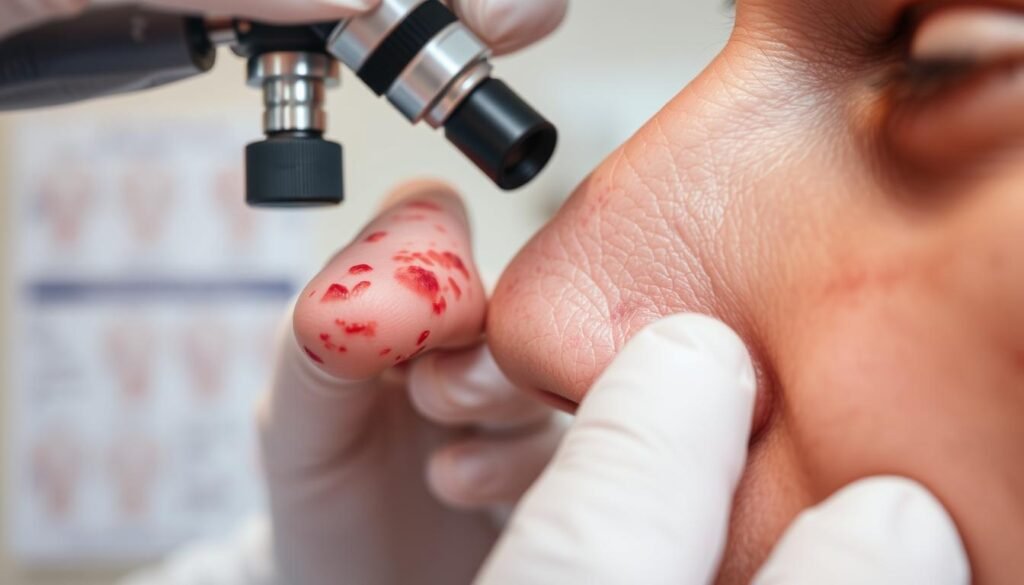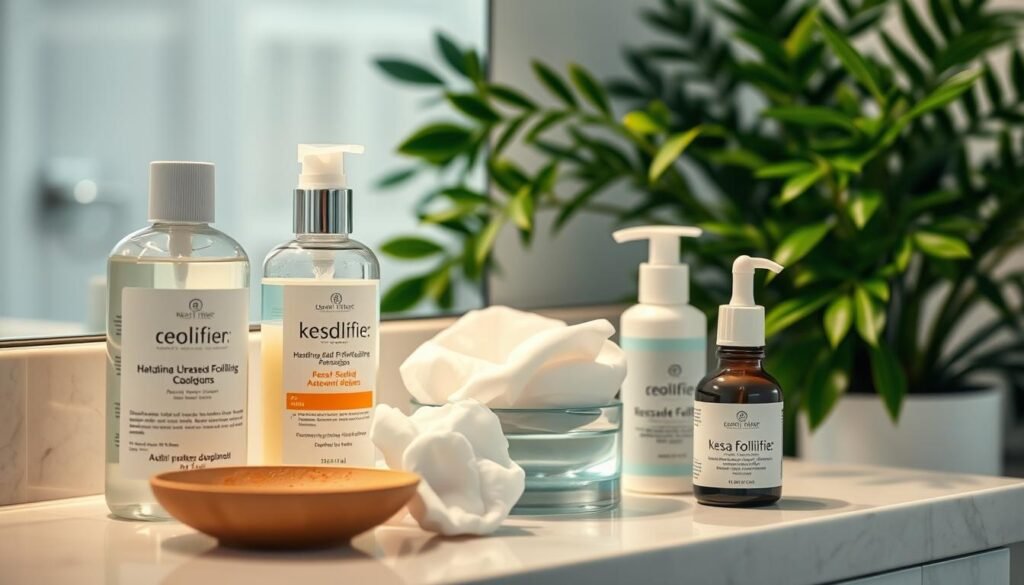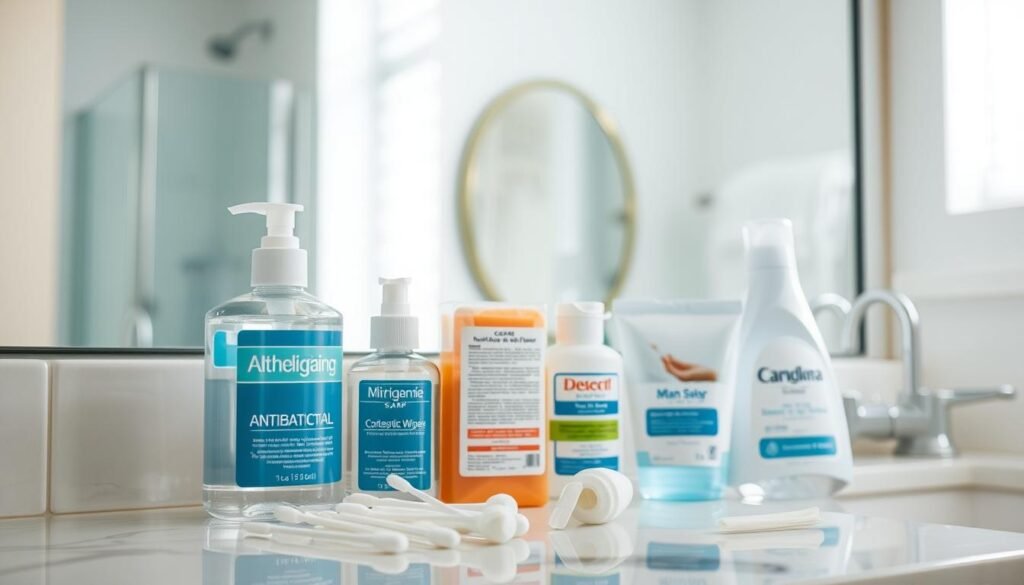Roughly 30% of folliculitis cases are due to Staphylococcus aureus. This is a common germ causing infections in the nose. Understanding nasal folliculitis is key. This is when hair follicles in the nostrils get inflamed or infected. It can be set off by things like picking your nose or blowing it a lot.
This infection leads to symptoms that can make you uncomfortable. It’s vital to know the causes of nasal folliculitis and how to treat it. Doing so helps keep your nose healthy and stops the infection from coming back.
Key Takeaways
- Nasal folliculitis is commonly caused by bacterial infections, particularly Staphylococcus aureus.
- Visible symptoms often include redness, swelling, and pus-filled pimples inside the nostrils.
- Mild cases may respond well to at-home care, such as warm compresses and proper hygiene.
- For severe or recurrent instances, prescription medications like oral antibiotics may be necessary.
- Maintaining good hygiene is essential in preventing nasal folliculitis and reducing irritation.
- Consulting a healthcare provider is advised if symptoms persist or worsen despite self-care.
What is Nasal Folliculitis?
Nasal folliculitis affects the hair follicles in the nose, causing inflammation and discomfort. It can be caused by bacteria, fungi, or viruses. It’s essential to know about the different causes.
Those with nasal folliculitis may notice redness, swelling, and sometimes pus. Even though it’s similar to other skin issues, knowing its unique signs helps in treatment.
Often, nasal folliculitis gets better without needing special treatment. This happens in around 65-70% of cases. But if not treated, it could lead to more serious problems. So, quick diagnosis and action are key.
To learn more about how to handle this issue, check out detailed medical literature. It offers insights into different treatment methods.
Causes of Nasal Folliculitis
Nasal folliculitis comes from different factors that allow infections to happen. Knowing the causes helps recognize symptoms early for treatment. Mainly, bacteria like Staphylococcus are to blame.
Common Causes
Minor injuries can lead to infection in the nasal hairs, such as:
- Nose picking
- Excessive blowing of the nose
- Nasal hair removal
These actions can make it easy for bacteria to enter and cause inflammation. Being in environments where moisture gets trapped can also increase risk. This includes people who often wear rubber gloves or high boots. Similarly, using certain creams or taking antibiotics for a long time raises infection chances.
Underlying Health Conditions
Having certain health issues can make nasal folliculitis more likely. This includes diabetes, HIV/AIDS, or other immune-compromising conditions. Also, cancer medications can boost the infection risk for nasal hairs.
Symptoms of Nasal Folliculitis
Nasal folliculitis comes with noticeable signs. These can be worrying for those affected. Knowing the symptoms is key for timely treatment.
Visible Signs
Visible signs are a clear indicator of nasal folliculitis. These signs include:
- Erythema (redness) around the nostrils or inside them.
- Swelling in the area.
- Pimple-like bumps at the nostrils’ entrance.
- Small crusts or boils, adding to discomfort.
Spotting these signs early can lead to a faster reaction. This may help avoid further health issues.
Pain and Discomfort
Pain and discomfort are significant in nasal folliculitis. Many report:
- Tenderness in the nose, which makes daily tasks hard.
- Difficulty breathing due to swelling.
- Challenges with nasal hygiene, caused by pain.
Dealing with the pain is essential for patient comfort. It’s a key part of managing nasal folliculitis.
Diagnosis of Nasal Folliculitis
A healthcare professional often detects nasal folliculitis during a check-up. They look at the patient’s past health to find what might have caused it. Sometimes, lab tests are needed to find the exact bacteria causing the issue. Staphylococcus aureus, especially types that respond to common antibiotics, is usually the main suspect.
It’s crucial to diagnose nasal folliculitis quickly and correctly. This helps avoid serious problems like facial cellulitis or blood clot issues in the brain’s veins. If someone has a fever or problems with facial muscles, it may mean the infection is getting worse. An article in “Diagn Microbiol Infect Dis” shows that most people get better without any serious issues if it’s caught and treated early.
To diagnose it, doctors look for swelling, redness, and crusts around the nose. They may also test a nose swab in the lab to find bacteria like methicillin-sensitive Staphylococcus aureus. This helps figure out how to treat it. Getting the right diagnosis means patients can get clear advice and the right treatment.

| Diagnostic Method | Description |
|---|---|
| Physical Examination | Assessment of visible symptoms such as swelling and redness. |
| Patient History | Review of medical history and potential triggers for folliculitis. |
| Nasal Swab Culture | Lab test to identify specific bacteria causing the infection. |
| Laboratory Tests | Comprehensive tests to assess for complications if needed. |
Treatments for Nasal Folliculitis
Nasal folliculitis can make you feel uncomfortable and annoyed. Treatments aim to lower infection and ease symptoms. They often include topical and systemic methods, based on how serious and frequent the condition is.
Topical Treatments
Topical treatments are usually the first step. They include:
- Mupirocin and Bacitracin: These are antibiotics. You apply them to the spot, fighting the bacteria causing the infection.
- Warm Compresses: Warmth can ease symptoms and help heal.
- Saline Washes: These clean the nasal areas and lessen swelling.
These topical treatments are great for light to average cases. Always follow your doctor’s advice for them to work well.
Oral Antibiotics
If topical methods aren’t enough, you might need oral antibiotics. These are for tougher or returning cases of folliculitis. The antibiotic chosen depends on the bacteria causing the issue. Usually, it’s a prescription medicine targeting the specific bacteria.
Management of Nasal Folliculitis
Dealing with nasal folliculitis starts with simple home treatments. These methods help ease symptoms and speed up healing. They also prevent further issues. It’s vital to keep the nasal area clean. For example, not picking your nose is important to avoid complications. Here are some easy home remedies:
At-Home Remedies
- Warm Compress: A warm compress reduces swelling and eases pain. Use a cloth dipped in warm water and put it on the sore spot for 15 to 20 minutes.
- Salt-water Solutions: Cleaning with salt water keeps the nose clean. It removes irritants and helps with healing.
- Over-the-Counter Pain Relief: You can take pain relievers like ibuprofen or acetaminophen as needed. They help deal with the pain from nasal folliculitis.
If symptoms don’t get better, or if you notice severe pain or swelling, it’s key to know when to see a doctor. Getting advice from a professional can offer more treatment options. It also lowers the chance of worse problems.
When to See a Doctor
See a doctor if symptoms like pain, swelling, or redness get worse. Signs of a spreading infection are:
- Increasing pain that doesn’t get better with home treatment
- Wider spread of redness or swelling
- Fever or chills
It’s crucial to take these signs seriously. Without proper care, nasal folliculitis can turn into more serious issues like cellulitis or an abscess. To fully understand nasal folliculitis and how to treat it, check out this resource for helpful information.

| Symptoms | When to See a Doctor |
|---|---|
| Pain and discomfort | Severe or worsening pain |
| Redness and swelling | Expanding redness or swelling |
| Localized heat | Fever or other systemic symptoms |
Preventing Nasal Folliculitis
To prevent nasal folliculitis, mix good hygiene habits and lifestyle changes. Simple prevention tips can cut down the risk of getting infections and irritations in this delicate area.
Washing hands regularly is key. Keeping your nostrils clean reduces bacteria risk, which can cause nasal folliculitis. It’s also critical to avoid things that could hurt your nose area. Like, don’t pick your nose or blow it too hard to stop irritation and swelling.
If you’re likely to get sick easily, like those with low immunity or diabetes, it’s good to keep clean. Infections can grow fast in some people, so paying attention is crucial.
Adding more vitamin D to your diet may also help stop different acne-like problems, such as nasal folliculitis. If your nose does get irritated, putting warm compresses on it can ease the pain. Do this three times a day for 15 to 20 minutes each.
By following these prevention tips and staying clean, many people can greatly reduce their nasal folliculitis risks.
Potential Complications of Nasal Folliculitis
Nasal folliculitis can cause a lot of problems if not treated. It can quickly become serious, leading to big infections and health issues. One major risk is cellulitis. This can spread to the areas around it, causing more discomfort and health issues.
Sometimes, it can even lead to very dangerous conditions like cavernous sinus thrombosis. This is a blood clot in the cavernous sinus. It can have severe effects on your brain. That’s why knowing about these risks is key. It helps you get the medical care you need fast.
If you don’t treat it, you might have chronic pain or lasting skin problems. These can really impact how you feel every day. Dealing with symptoms early is important. It can help avoid serious issues from nasal folliculitis.
Lifestyle Impact on Nasal Folliculitis
Your lifestyle plays a big part in nasal folliculitis. It can affect how often and how severe it is. Making certain lifestyle choices can make symptoms better or worse. This includes things like what you eat, how stressed you are, and how clean your surroundings are.
Diet matters a lot for your immune health. Eating healthy can cut down on inflammation. On the other hand, processed and sugary foods might make things worse.
Lowering stress with stress management actions like yoga or meditation is good. These activities can reduce cortisol levels which helps your skin. Stress tends to make inflammation and symptoms of nasal folliculitis worse.
Keeping your living space clean is important too. It keeps away things that could start folliculitis. Cleaning regularly helps keep bacteria and other bad stuff away, which is good for your skin.
Staying clear of irritants matters. Harsh skincare products or pollution should be avoided. Choosing gentle cleansers helps avoid making things worse and can treat nasal folliculitis.
Good hygiene is key. Washing your face often, avoiding close contact with others, and neat facial hair can control the impact of lifestyle on nasal folliculitis.
| Lifestyle Factor | Impact on Nasal Folliculitis |
|---|---|
| Diet | Healthy food helps immune system; bad food could cause problems. |
| Stress | Too much stress can increase inflammation; managing it helps. |
| Hygiene | Cleanliness reduces harmful bacteria; using soft products is better. |
| Environmental Cleanliness | Clean surroundings lower the risk of starting folliculitis. |
By adopting a holistic lifestyle, you can greatly affect nasal folliculitis. This approach fosters healing and prevention.
Importance of Hygiene in Treatment
Hygiene plays a key role in treating conditions like nasal folliculitis. It greatly lowers the risk of infections which are key to getting better. Washing your hands often can lessen the spread of bacteria and stop further issues. Experts say that good hand washing can cut down on bacteria on hands, leading to improved health.
For simple cases of folliculitis, sticking to clean habits can see the problem go away in 2-7 days. Using warm compresses every few hours, for 10-20 minutes, can ease and help treat deeper cases. This shows why keeping up with hygiene matters even more after treatment.
About 20-30% of people may carry Staphylococcus aureus, a germ tied to deep folliculitis. This makes it clear how vital proper hygiene is to fight and remove these germs. For those who often get folliculitis, using mupirocin ointment in their nose can help stop Staphylococcus aureus from coming back.
Taking bleach baths a few times a week can also cut down on germs, helping with treatment. You use 1/2 cup of bleach in a full tub of water. This step, along with overall careful hygiene, can reduce the chances of getting diseases like Pseudomonas folliculitis. This disease often gets better on its own in 2-14 days in healthy folks.
To sum up, fighting nasal folliculitis successfully means valuing hygiene. Avoid sharing personal stuff, and wash towels and bed sheets often to make a healing-friendly setting. You can find more about this by checking health-related resources.

Research and Advancements in Treatment
Research is key in bettering care for nasal folliculitis patients. About 3-10% of adults are affected. This condition is linked to Staphylococcus aureus in 30-50% of cases. New treatment methods for individual needs are being explored by researchers.
There have been strides in both topical and oral antibiotic treatment. Topical ones work about 70-80% of the time. Oral ones are effective 80-90% of the time. This information helps us understand the treatment options.
Sometimes, surgery is needed in 5-10% of severe cases. Clinical trials are ongoing to better treatment plans. With a 20-30% chance of return, there’s a big push to enhance treatments and care approaches.
In 2014, experts updated treatment guidelines due to the growing problems associated with conditions like nasal folliculitis. They highlighted the need for proper management and regular 4-6 week checks until getting better.
| Aspect | Data |
|---|---|
| Prevalence among adults | 3-10% |
| Staphylococcus aureus carriers | 30-50% |
| Gender ratio (Men:Women) | 2:1 |
| Recurrence rate | 20-30% |
| Topical antibiotics success rate | 70-80% |
| Oral antibiotics success rate | 80-90% |
| Surgical intervention requirement | 5-10% |
| Follow-up recommendation | Every 4-6 weeks |
With continuous research, the outlook for nasal folliculitis treatment is bright. The goal is to greatly boost how well treatments work and patient experiences.
Conclusion
Nasal folliculitis can be a nuisance but is usually manageable. With the right info and quick action, comfort and nasal health improve. Good hygiene and preventive steps greatly cut down recurrence chances.
Getting diagnosed early and using the right treatment methods are vital. These may include creams and oral antibiotics. For ongoing issues, it’s essential to see a doctor. Treatment must be personalized because everyone’s experience is different. Using these methods not only helps sufferers but makes everyone’s surroundings healthier.
Proper care and a proactive stance can lead to effective nasal folliculitis treatments. Being aware and acting quickly when symptoms show up empowers people. This way, they can improve their health and life quality.
